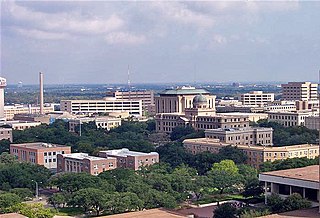
Robertson County is a county in the U.S. state of Texas. As of the 2020 census, its population was 16,757. Its county seat is Franklin. The county was created in 1837 and organized the following year. It is named for Sterling C. Robertson, an early settler who signed the Texas Declaration of Independence.

Randall County is a county located in the U.S. state of Texas. As of the 2020 census, its population was 140,753. Its county seat is Canyon. The county was created in 1876 and later organized in 1889. It is named for Horace Randal, a Confederate brigadier general killed at the Battle of Jenkins Ferry. The reason the county name differs from his is because the bill creating the county misspelled Randal's name.

Franklin County is a county located in the U.S. state of Texas. As of the 2020 census, its population was 10,359. The county seat is Mount Vernon.

Briscoe County is a county located in the U.S. state of Texas. As of the 2020 census, the population was 1,435. Its county seat is Silverton. The county was created in 1876 and later organized in 1892. It is named for Andrew Briscoe, a soldier during the Texas Revolution.

Owensville is the third largest town and the smallest of the five larger communities in Gibson County, Indiana, United States. The population was 1,338 in 2020.

Owensville is a city in Gasconade County, Missouri, United States. The population was 2,757 at the 2020 census.

Sealy is a city in Austin County in southeastern Texas, United States. The population was 6,839 at the 2020 census. Sealy is located 49 miles (79 km) west of the downtown Houston area, on the most eastern part of the Texas-German belt region, an area settled by German emigrants.

Silverton is a city in Briscoe County, Texas, United States. The population was 629 at the 2020 census.

Martindale is a city in Caldwell County, Texas, United States. It is part of the Austin metropolitan area. The population was 1,253 at the 2020 census.

Lott is a city in Falls County, Texas, United States. As of the 2020 census, the city population was 644.

Hallsville is a city in Harrison County, Texas, United States, located 13 miles (21 km) west of the county seat, Marshall, on U.S. Highway 80. The population was 3,577 at the 2010 census, up from 2,772 at the 2000 census. The 2020 census revealed that Hallsville's population was 4,277.

Shallowater is a city in Lubbock County, Texas, United States. Shallowater is on U.S. Route 84 and the Burlington Northern Santa Fe line, 12 miles (19 km) northwest of Lubbock. Its population was 2,484 at the 2010 census. It is part of the Lubbock metropolitan statistical area.

Madisonville is a city in Madison County, Texas, United States. The population was 4,420 at the 2020 census. It is the county seat of Madison County. Both the City of Madisonville and the County of Madison were named for U.S. President James Madison, the fourth chief executive.

Iraan is a city in Pecos County, Texas, United States. Its population was 1,055 at the 2020 census. The city's name is an amalgamation of the first names of Ira and Ann Yates, owners of the ranch land upon which the town was built.

Corrigan is a town in north central Polk County, Texas, United States. It is located along U.S. Highway 59 and is approximately 100 miles from Houston. Its population was 1,477 in the 2020 census.

Franklin is a city in, and the county seat of, Robertson County, Texas, United States. It is within the Brazos Valley, on the cusp of the East and Central Texas regions. As of the 2020 census, the city population was 1,614. The original name of the town was Morgan and it was made county seat in 1879.

Hearne is a city in Robertson County, Texas, United States. As of the 2020 census, the city population was 4,544. The city is named for a family that settled in the area in the 19th century and promoted the construction of rail lines through the city.

Gladewater is a city in Gregg and Upshur counties in the U.S. state of Texas with a 2020 census population of 6,134.

San Patricio is a city in Nueces and San Patricio counties in the U.S. state of Texas. The population was 384 at the 2020 census.

Bryan–College Station is a metropolitan area centering on the twin cities of Bryan and College Station, Texas, in the Brazos Valley region of Texas. The 2010 census placed the population of the three county metropolitan area at 255,519. The 2019 population estimate was 273,101.




























